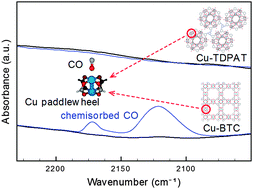Influence of gas packing and orientation on FTIR activity for CO chemisorption to the Cu paddlewheel†
Abstract
In situ Fourier-transform infrared (FTIR) spectroscopy is able to probe structural defects via site-specific adsorption of CO to the Cu-BTC (BTC = 1,3,5-benzenetricarboxylate) metal–organic framework (MOF). The temperature-programmed desorption (TPD) of CO chemisorbed to Cu-TDPAT (TDPAT = 2,4,6-tris(3,5-dicarboxylphenylamino)-1,3,5-triazine) is virtually identical to Cu-BTC, suggesting CO chemisorbs to the open metal site at the axial position of the copper paddlewheel that is the building unit of both MOFs. Yet, despite an increased gravimetric CO : Cu ratio, CO chemisorbed to Cu-TDPAT is FTIR inactive. We rule out the presence of residual solvent, thermal degradation, adsorption temperature, and ligand-induced electronic effects at the adsorption site. TPD at increased pressure suggests the multiple CO per Cu site rearrange in Cu-TDPAT as a dynamic function of temperature and pressure. Thus, the FTIR inactivity of CO chemisorbed to Cu-TDPAT is attributed to orientation and/or packing of the CO relative to the Cu binding site. The results suggest dynamic chemisorption complicate extension of a site-specific in situ FTIR probe of gas adsorption. For both Cu-BTC and Cu-TDPAT, the in situ FTIR probe is a less sensitive probe of defects than X-ray photoelectron spectroscopy and nitrogen adsorption.



 Please wait while we load your content...
Please wait while we load your content...